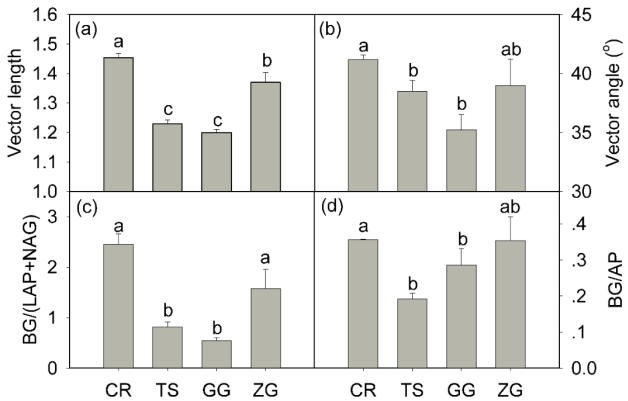
A large portion of degraded croplands around the world are undergoing land-use conversions, which aim to improve soil fertility of degraded croplands and optimize the structure and function of ecosystems. To better evaluate the effectiveness of cropland conversion, more mechanistic features related to ecosystem structure and function should be considered besides soil fertility.
Soil microbes play a key role in decomposing soil organic matter and controlling soil biogeochemical cycles. The growth and activity of soil microbes are often limited by resources such as carbon (C), nitrogen (N), and phosphorus (P), which is referred to as microbial resource limitation.
Previous studies showed that cropland conversions can change soil C, N and P status, thus altering microbial resource limitation. To date, however, how cropland conversions affect microbial resource limitation remains poorly understood.
In a paper recently published in Geoderma, researchers from the Institute of Subtropical Agriculture (ISA) of the Chinese Academy of Sciences studied three common cropland conversion strategies in a karst area of southwest China.
The three strategies were conversion with Toona sinensis (TS), with Guimu-1 hybrid elephant grass (GG), and a combination of Zenia insignis and Guimu-1 hybrid elephant grass (ZG) using cropland (CR) with maize-soybean rotation as reference. Enzymatic stoichiometry was calculated and used as an indicator of microbial resource limitation.
The team found that soil enzyme activity was altered after cropland conversions, which was strongly related to changes in soil properties. Enzymatic stoichiometry further showed that microbial C limitation was mitigated under all three conversion strategies, but N and P limitations were aggravated under TS and GG.
"The mitigated limitation of microbial C may be due to the elevated soil C content, and the aggravated microbial N and P limitation may be caused by increased soil C/N and C/P, respectively," said CHEN Hao, a doctoral researcher at ISA and first author on the paper.
The findings suggest that cropland conversion can change microbial resource limitation, which should be considered in the assessment and management of rebuilding ecosystems after cropland conversions.
This work was supported by the National Natural Science Foundation of China, Youth Innovation Promotion Association of CAS to Hao Chen, National Key Research and Development Program of China, Natural Science Foundation of Guangxi Province of China, National High-level Talents Special Support Program to Dejun Li, and Guangxi Bagui Scholarship Program to Dejun Li.

Effects of cropland conversion on indicators of microbial resource limitation (Image by CHEN Hao)

86-10-68597521 (day)
86-10-68597289 (night)

52 Sanlihe Rd., Xicheng District,
Beijing, China (100864)

